Best patio plants: 21 picks for year-round color and style
These top-performing patio plants will keep your space looking fabulous every month of the year

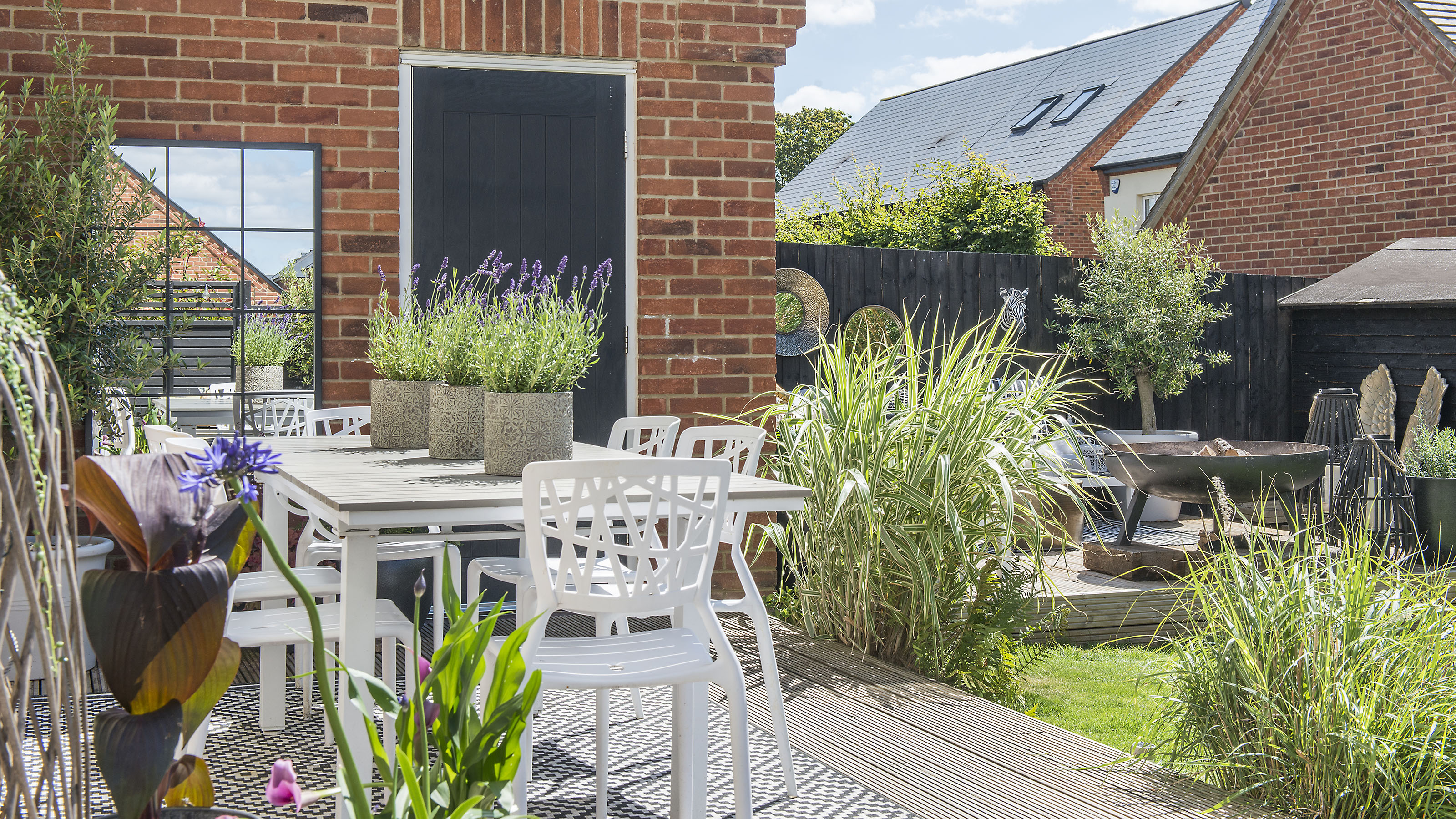
Choosing the right patio plants is as important as the layout and design. As well as adding beauty and style, planting can be used to soften walls and paving, zone areas, as well as create privacy and shade. A few eye-catching specimen plants in containers helps to define a patio space, but to create unity, be inspired by the planting that’s been successful in the rest of your garden – particularly if you can see your whole plot from the windows of the house.
Before deciding what to plant, first assess how much sun or shade your patio gets. Full sun is a minimum of six hours direct sun a day, part shade is about half that time. Check your USDA hardiness zone too, and make sure your plant choices are right for your climate. Bear in mind that plants in containers are usually more sensitive to frost and cold, so those that are to remain in pots all year round need to be hardy and able to cope with whatever weather is thrown at them.
If you have somewhere you can bring pots undercover over winter – a greenhouse, porch or conservatory for example – then the range of plants you can grow opens up considerably. Citrus plants, agave and alstroemeria will all benefit from indoor protection and carry on looking good through winter.
Whatever your taste and style for your patio ideas, ringing the changes with seasonal flowers is one of the joys of gardening.
Get the color party started with the best patio plants
Think about the type of patio plants you want grow. Do foliage plants with different leaf shapes and textures float your boat? How important is scent to you? Are you drawn to an understated look for your patio gardening ideas using monochrome colors, or are clashing pinks and oranges your thing?
Narrow down your favorites with our selection of stunning patio plants for every type of space.
1. Tulips
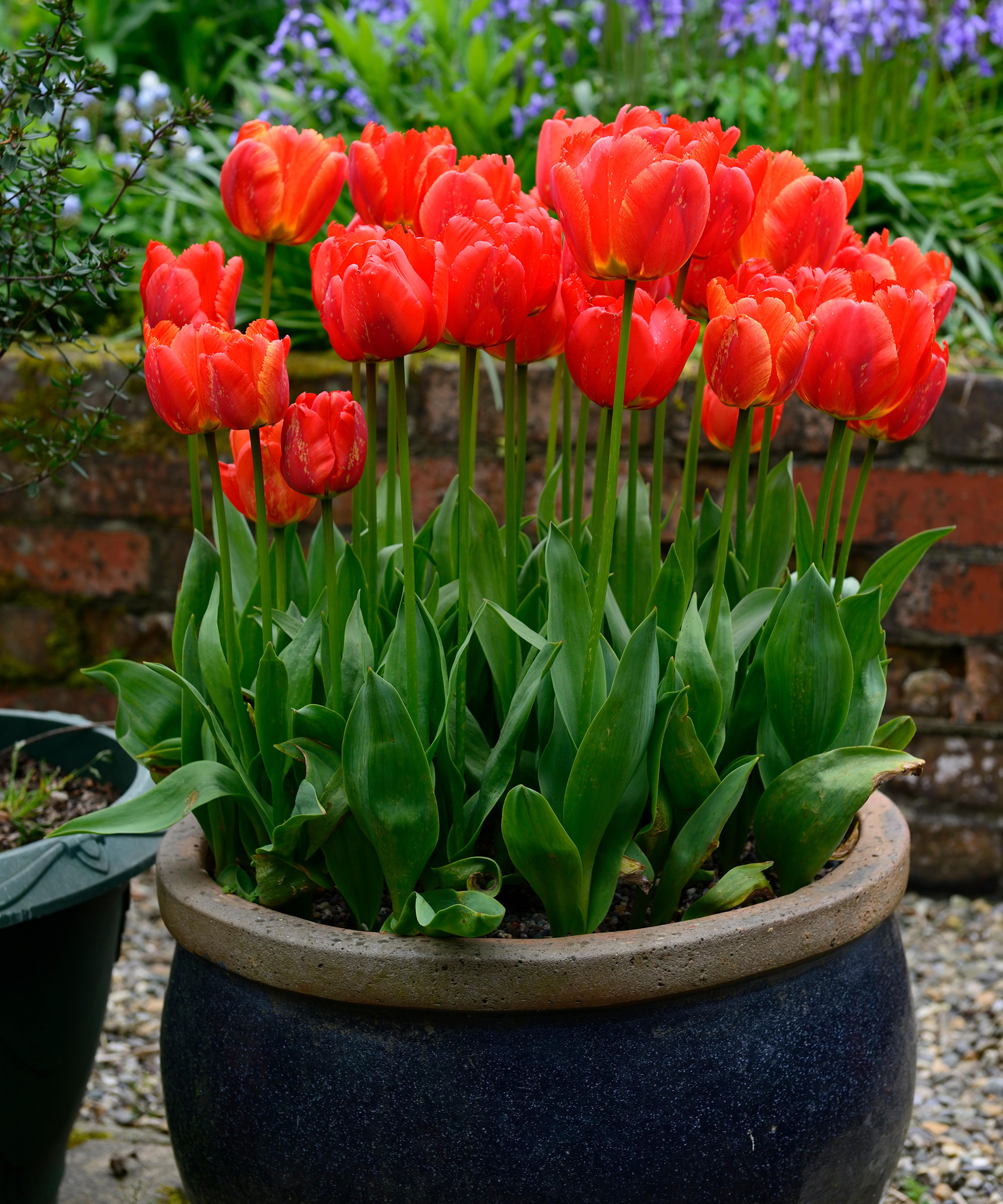
- Hardiness: USDA 3-8 (UK H6)
- Height: 5.5in (15cm) - 23in (60cm)
- Spread: 4in (10cm) – 6in (25cm)
- Best for: Full sun
Planting tulip bulbs is as close to magic as gardening ever gets. It’s thrilling to witness a rather plain-looking flower bulb transform itself into a thing of beauty. Coming in every color imaginable, tulips provide much-needed pops of color after early spring flowers have faded and summer ones have yet to appear.
Planting them as part of your spring container ideas couldn’t be easier either, and they are perfect for small patio ideas.
Knowing how and when to plant tulip bulbs is key to their success, however. The ideal planting time is late fall, before the ground freezes. You can leave planters outside all year round, provided the compost doesn’t get too wet. Alternatively, lift and store tulip bulbs once the foliage has turned yellow, leave them to dry, then store them in a brown paper bag somewhere dark and cool until you are ready to replant them later in the year.
2. Hostas
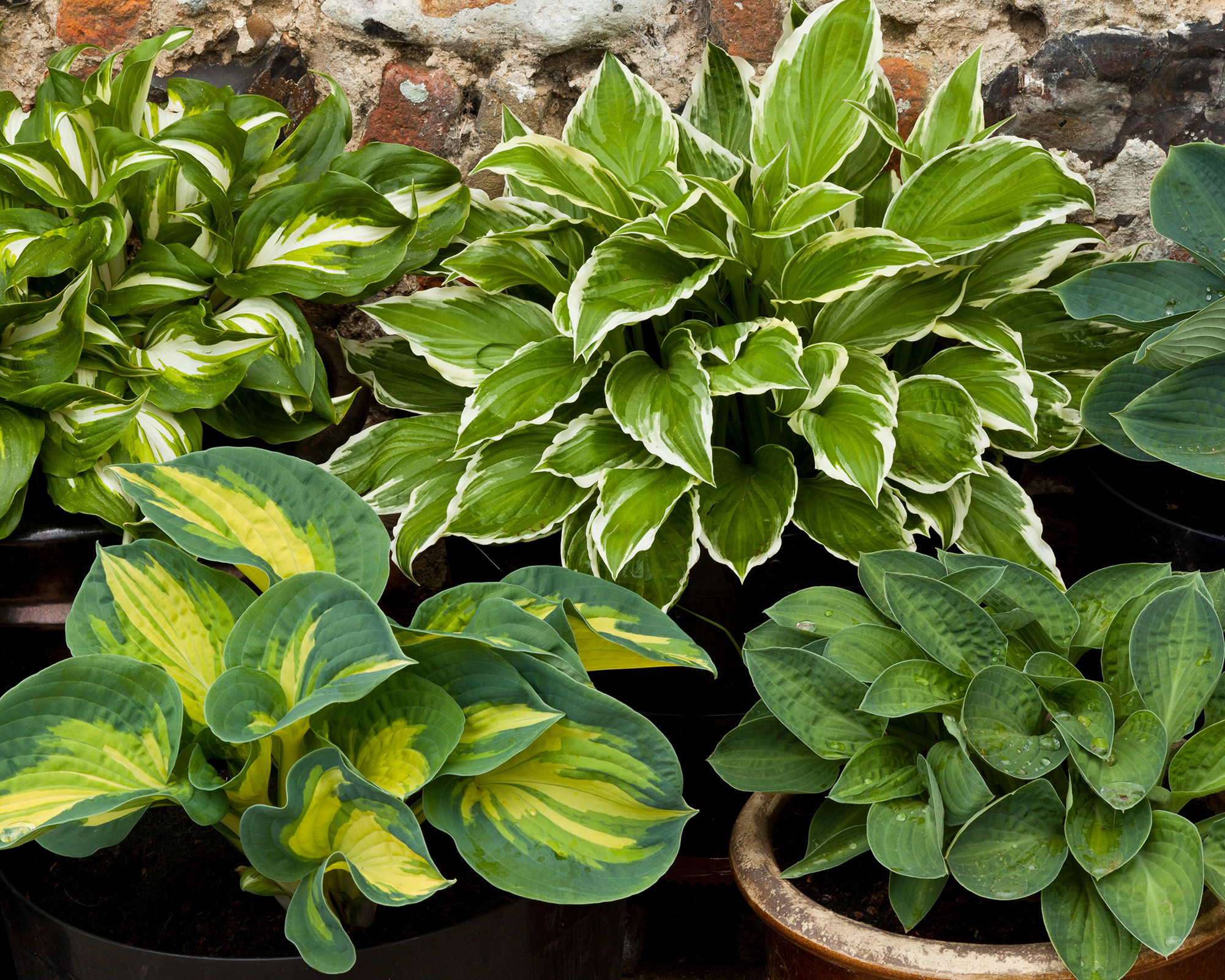
- Hardiness: USDA 3-8 (UK H6)
- Height: 4in (10cm) - 3ft 2in (1m)
- Spread: 4in (10cm) – 3ft 9in (1.2m)
- Best for: Partial or full shade
With their attention-grabbing foliage, hostas make good accents in garden borders adjacent to a patio, but they make an even bigger statement in pots on a patio or deck. They’re a must-have for a shaded spot, like under your patio cover ideas, where other plants might fail to thrive.
There are a huge number of varieties to choose from, ranging from those with tiny leaves like ‘Mouse Ears’ to dinner-plate sized leaves such as H.sieboldiana. And they come in a wide range of shades, from blue, green and variegated to gold and yellow, so there will be one to suit all tastes and styles.
Hostas have roots that are wider than they are long, so ideally choose a pot that is wider than it is deep. That said, that can look very elegant in tall, narrow pots, you just may have to divide the rootballs regularly. They prefer damp soil so if you don’t live somewhere that receives regular rainfall, watch for the compost drying out. Add slow-release fertiliser to the compost each spring and give them a nutrition boost in the summer with a liquid seaweed feed every couple of weeks.
3. Hardy succulents
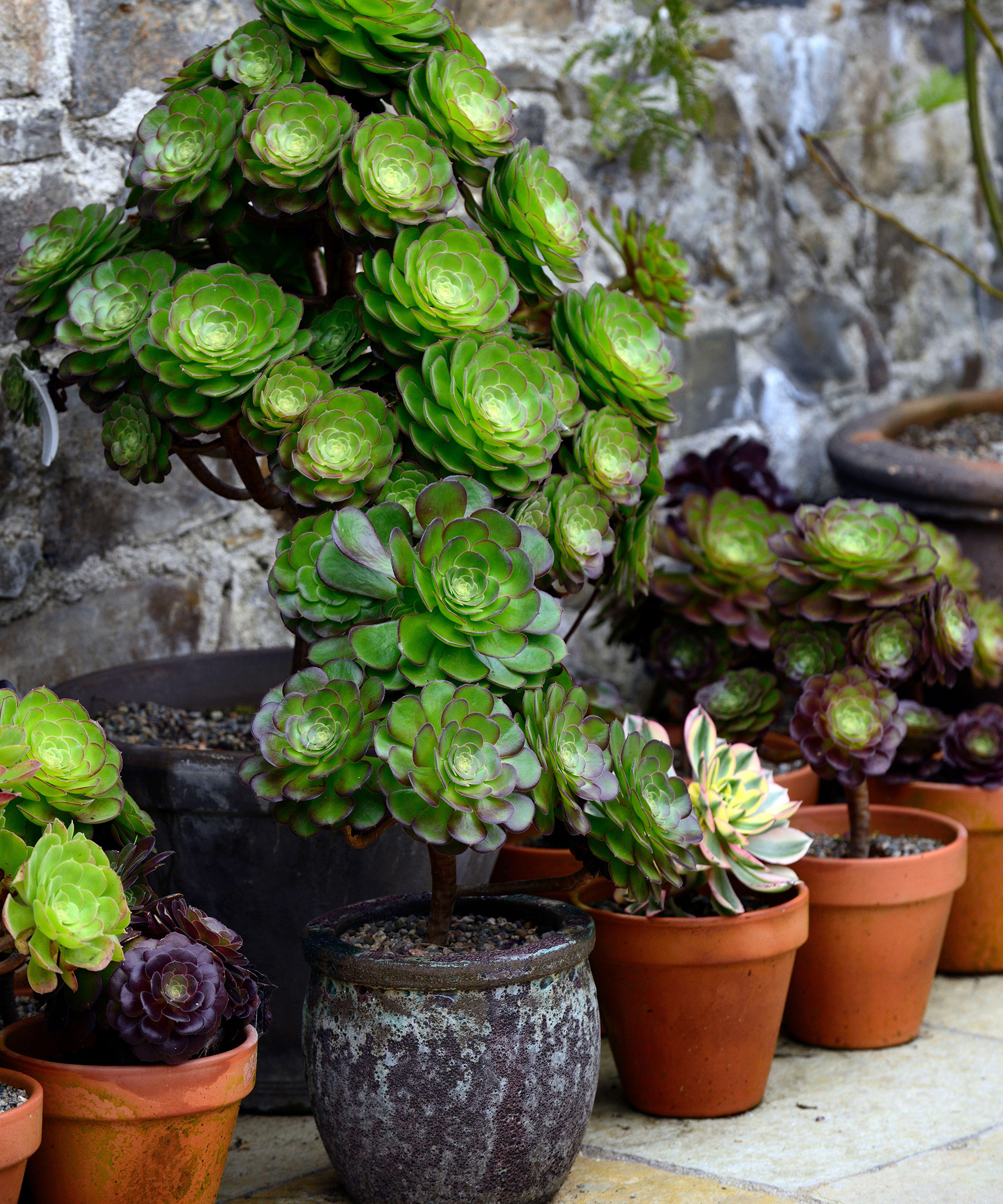
- Hardiness: USDA 5-9 (UK H6-3)
- Height: 4in (10cm) to 15in (40cm)
- Spread: 6in (15cm) to 19in (50cm)
- Best for: South-facing patios
Fleshy-leaved plants like agave and sedum have an architectural presence and add texture and color to a patio. Many can handle cold temperatures – some down to -20˚F – but they won’t put up with prolonged wet conditions. Ensure you use a sandy, gritty compost mix and let the compost dry out between waterings.
In wetter climates, move your succulent garden ideas indoors over winter. Agave parryi and Agave victoriae reginiae make striking focal points in containers while low-growing stonecrop (sedum) and delosperma are good for trailing over pots.
Sempervivum (hens and chicks) are easy to care for, while upright aeoniums are great for creating accents in summer container gardening ideas, but they’ll need protecting from frost. Check individual plant labels for the USDA climate rating.
4. Patio strawberries
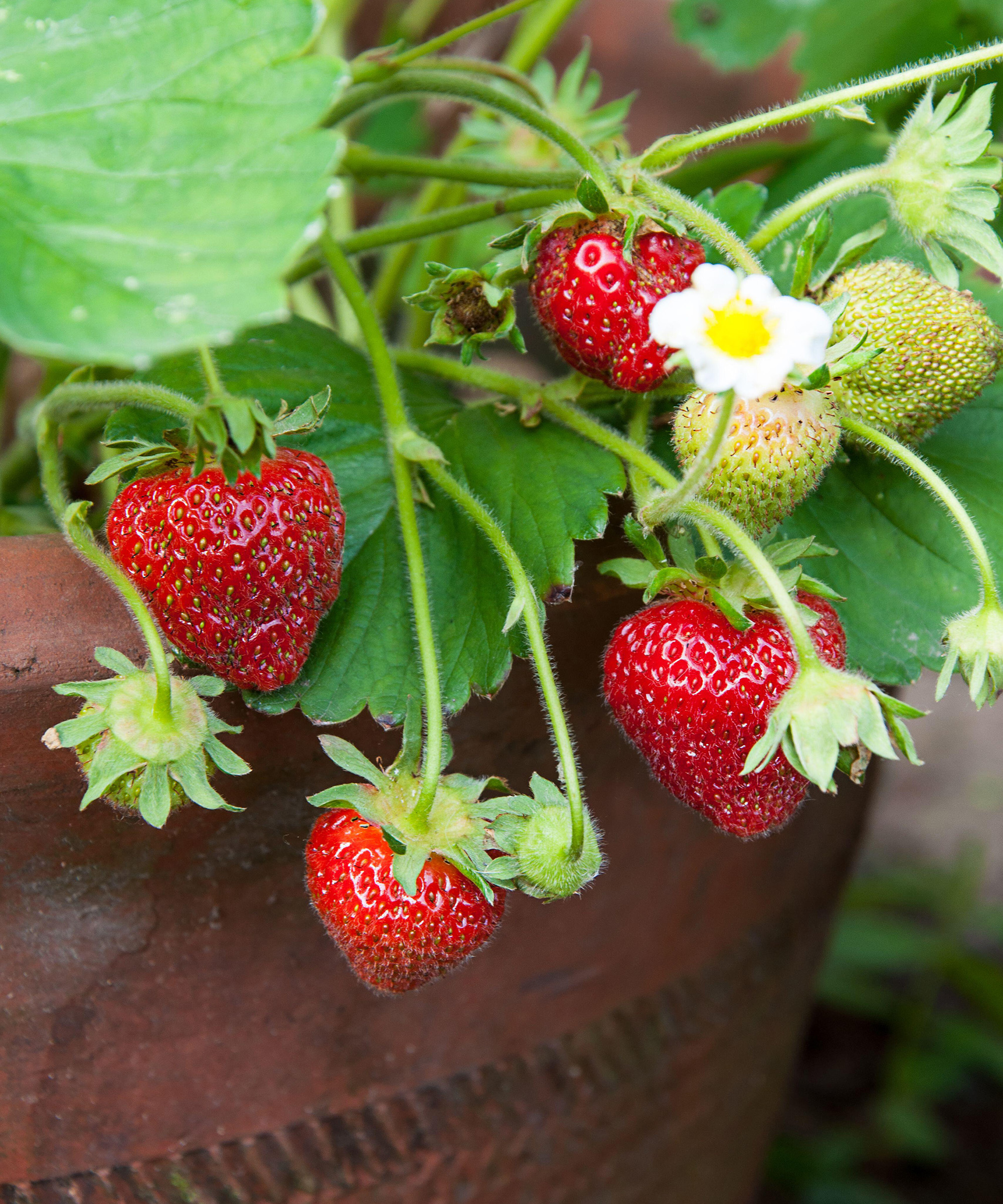
- Hardiness: USDA 5-10 (UK H6)
- Height: 1ft (30cm)
- Spread: 1ft (30cm)
- Best for: Full sun
Growing strawberries in pots, tubs, hanging baskets and grow bags is a great way to enjoy these tasty fruits in a small space. Only plant three to four plants per 15in (40cm) diameter pot – the more room the roots have, the happier the plants will be, and the more strawberries for you to pick.
The plants die back in winter and will start sprouting fresh new leaves in the spring. In summer, snip off any baby plants that are produced in the summer (potting these on if you wish to) and try to shade the pot as plants will be unhappy if their roots get too hot in sun.
Keep them regularly watered and fed with a fortnightly seaweed from spring to the end of summer. ‘Cambridge Vigour’ is an excellent variety and ‘Symphony’ is good for more northern, damp areas.
5. Roses
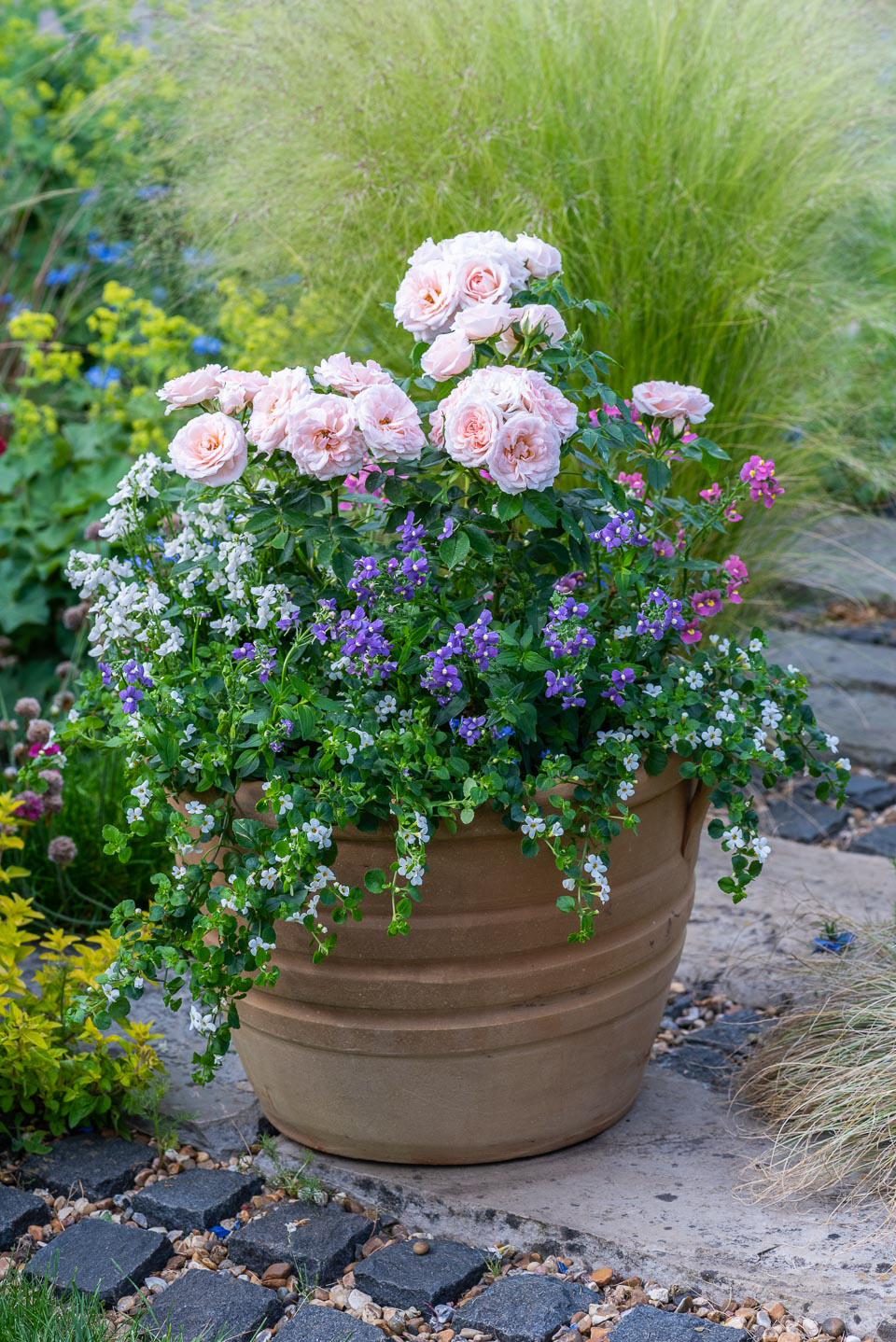
- Hardiness: USDA 4-11 (UK H6)
- Height: 4ft (120cm)
- Spread: 10ft (3m)
- Best for: Full sun/light shade
If you thought that roses were only for large country gardens and borders, think again. Plenty of rose varieties are suitable for growing on a patio, either in large containers or as climbers up a house wall or over a pergola. And roses in containers are perfect for your cottage garden patio ideas.
Warmer patios will absorb the sun’s rays and bring out the heady scent of these favorite blooms, and on a patio, you can enjoy their beauty and perfume close up.
Top rose choices for pots include: ‘Gabriel Oak’ with its deep pink, highly fragrant blooms, and ‘Desdemona’ for its understated pale peachy pink blooms that have a gorgeous scent. ‘Wollerton Old Hall’ has pale apricot blooms and looks lovely trained over a pergola, while the compact ‘Strawberry Hill’ is great in a trellis planter.
6. Olive trees
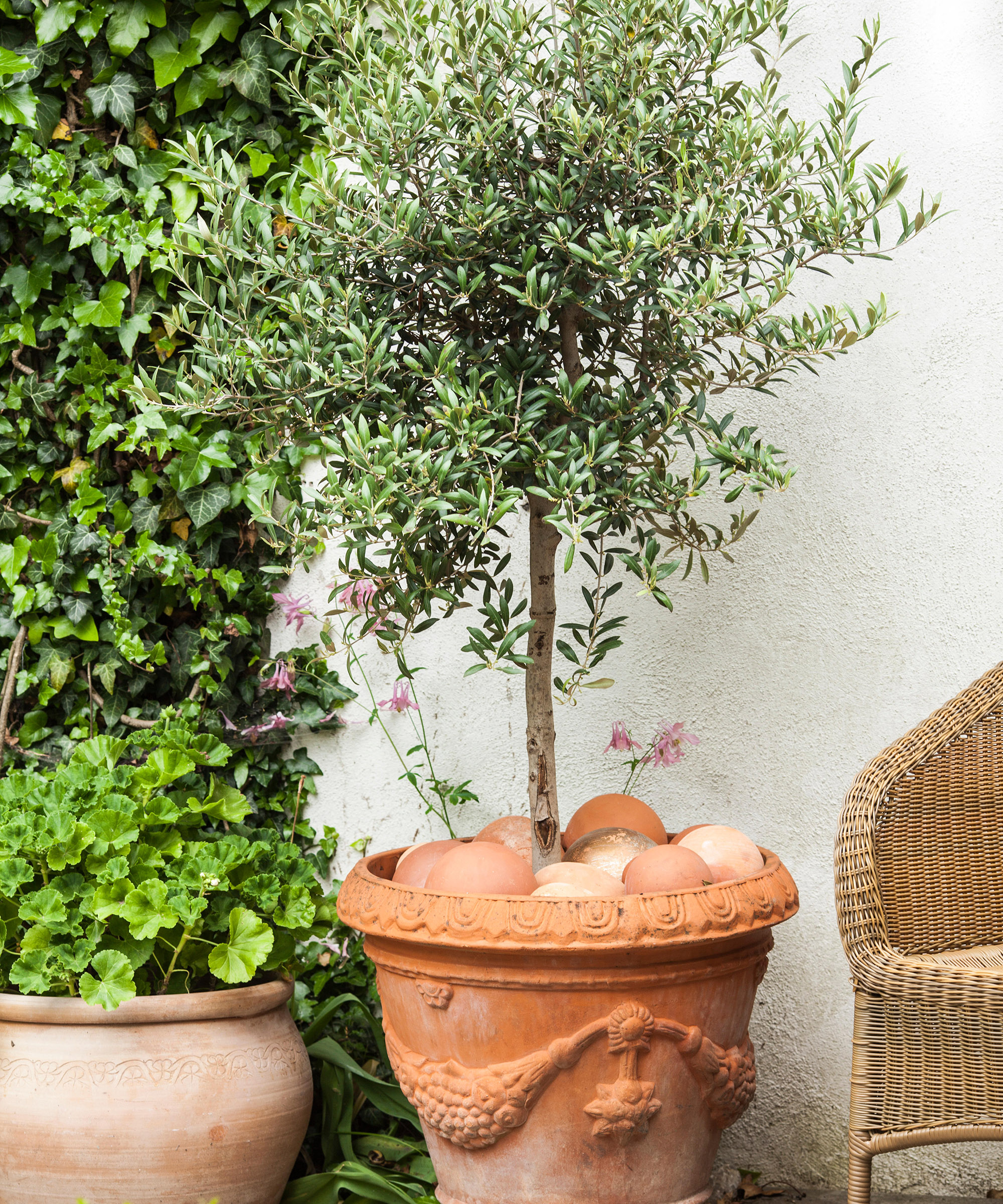
- Hardiness: USDA 8-10 (UK H4)
- Height: 2ft (60cm) to 6ft (2m)
- Spread: 2ft (60cm) to 6ft (2m)
- Best for: Full sun
The silvery grey-green foliage of this Mediterranean classic instantly gives your patio a holiday vibe, especially when partnered up with pink pelargoniums. Olive are one of the best trees to grow in pots or in the ground – they come in range of sizes from 3ft lollipop standards to mature trees with gnarled trunks.
Position in a sunny spot, preferably sheltered and away from cold, drying winds. Drainage is important – make sure your garden planter has a hole in the bottom and raise it up on pot feet; and add 20 per cent grit to the soil or compost. Insulate the inside of the pot with bubble wrap before you add the compost – saving you the hassle of wrapping the pot in winter (olive trees won’t tolerate frozen roots).
Despite liking free-draining soil, don’t let the compost dry out in summer, and apply a liquid seaweed feed fortnightly in summer to keep them looking healthy. Regular pruning in spring or early summer will help them keep their shape.
7. Trailing begonias
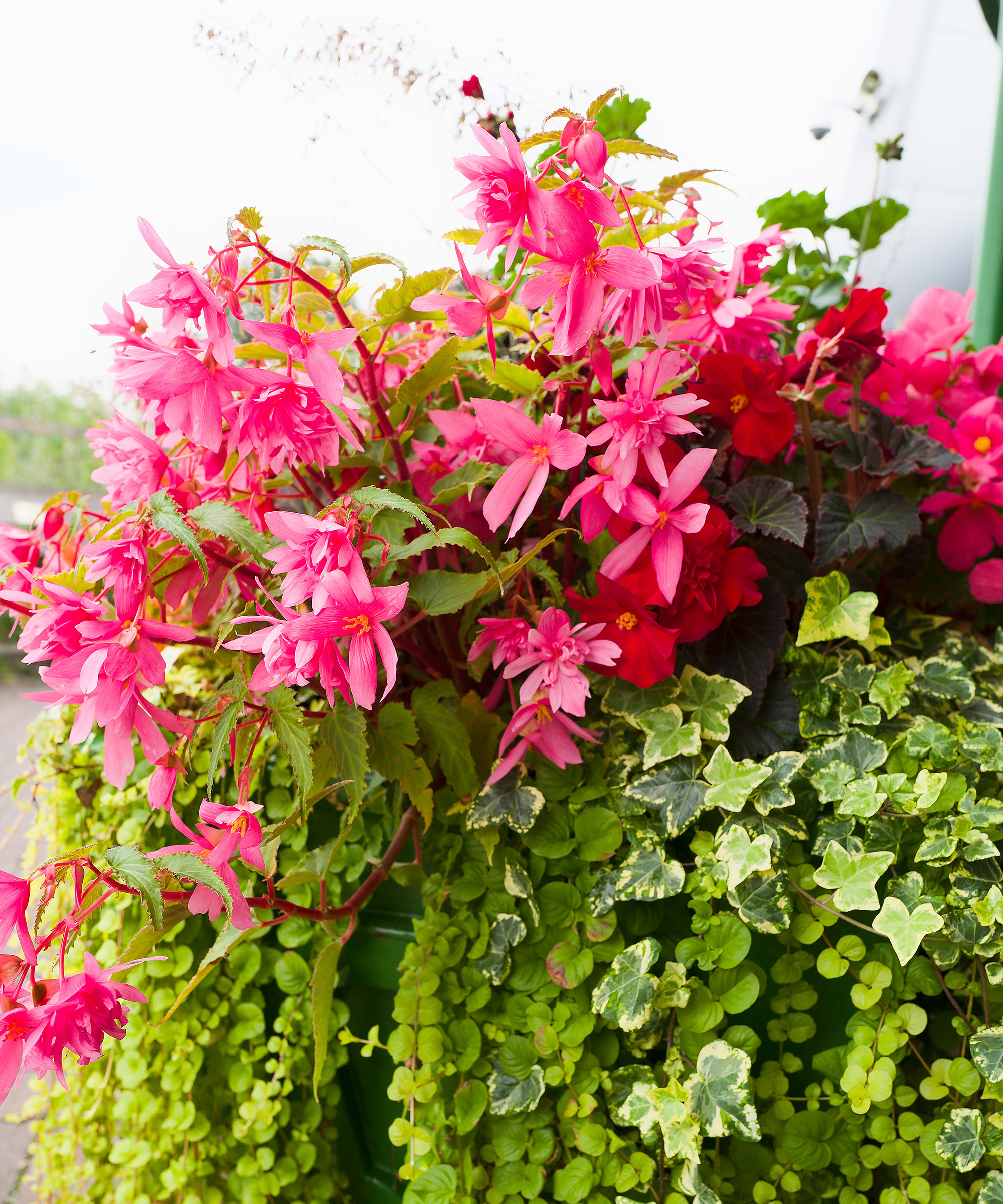
- Hardiness: USDA 10-11 (UK H1b)
- Height: N/A
- Spread: trailing branches to 18in (45cm)
- Best for: Part shade/full shade
Some people regard tender begonias as rather old fashioned but stroll around the neighborhood in summer and you’ll notice lots of them taking centre stage in gorgeous window box ideas. The trailing types are more elegant than upright varieties and if you position these patio plants high up – in hanging baskets or tall pots – their pendulous flowers can be better appreciated.
Start tubers off in spring, in pots of multipurpose compost. Keep them somewhere light and frost-free until late spring when they can be planted outside. If you’ve missed the planting window, garden centers will sell-garden-ready patio plants in early summer.
‘Pendula White’ has pink tinged hanging white flowers and looks lovely planted with heuchera ‘Ginger Snap’. If you want a more exotic-looking scheme, try the crimson red Begonia boliviensis ‘Santa Cruz Red’.
8. Pelargonium
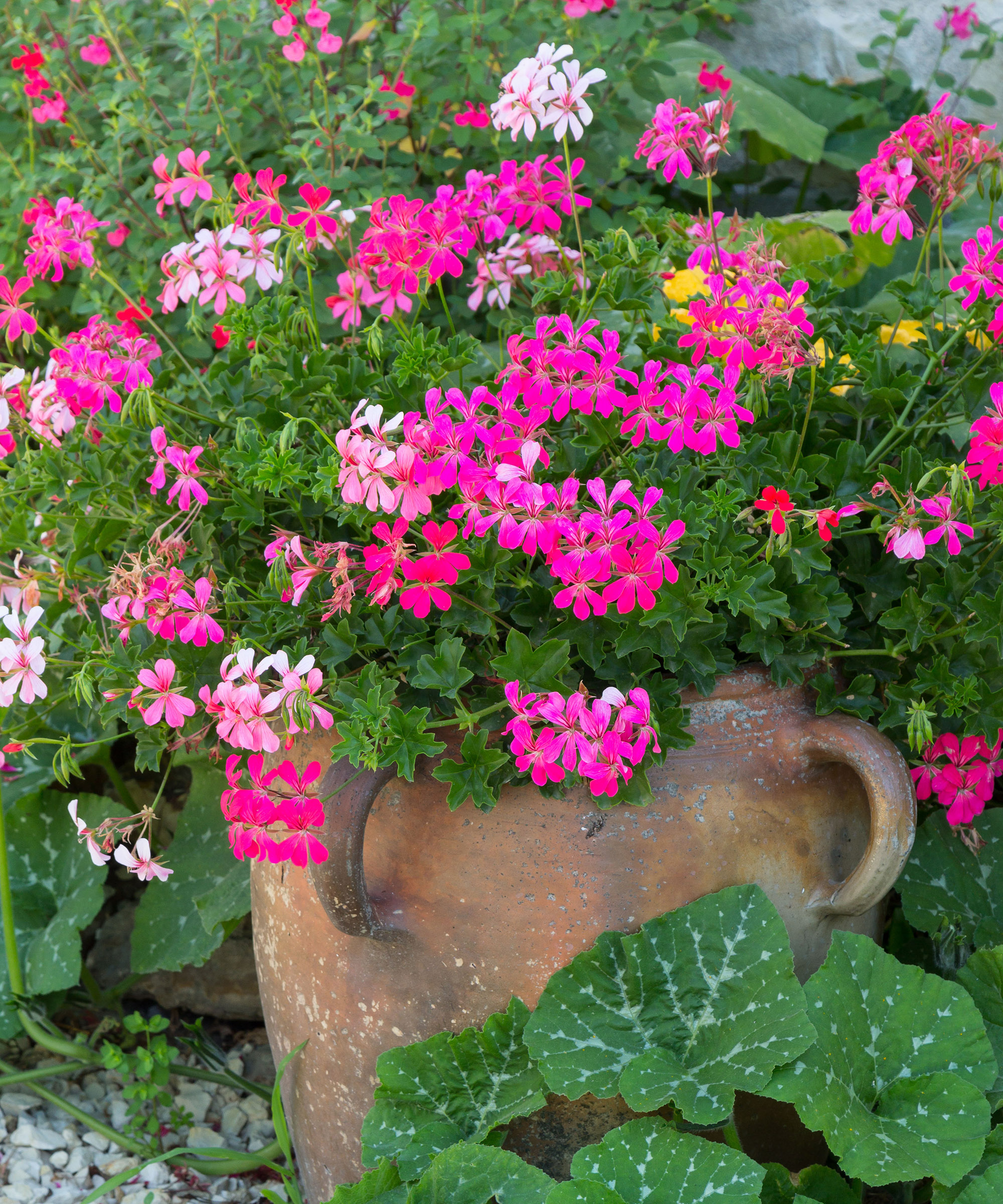
- Hardiness: USDA 10-11 (UK H1c)
- Height: 6-12in (15-30cm), 1-3ft (30-90cm)
- Spread: up to 2ft (60cm)
- Best for: Full sun
These South African beauties offer excellent value for budget patio ideas, flowering from early summer right through to the first frost. If you want to get serious about pelargoniums, there are specialist nurseries offering fancy and unusual varieties, but the zonal pelargoniums found at garden centres that come in shades of pink, red, orange and white, are great for adding splashes of instant color in window boxes and containers.
They don’t take a lot of looking after either – an application of slow-release fertilizer in the spring and occasional watering and deadheading of flowers is all they need. If you want to keep patio plants going for the following year and live in a colder zone, simply move the plants indoors – they’re great for brightening up a warm, sunny windowsill over winter.
9. Alstroemeria
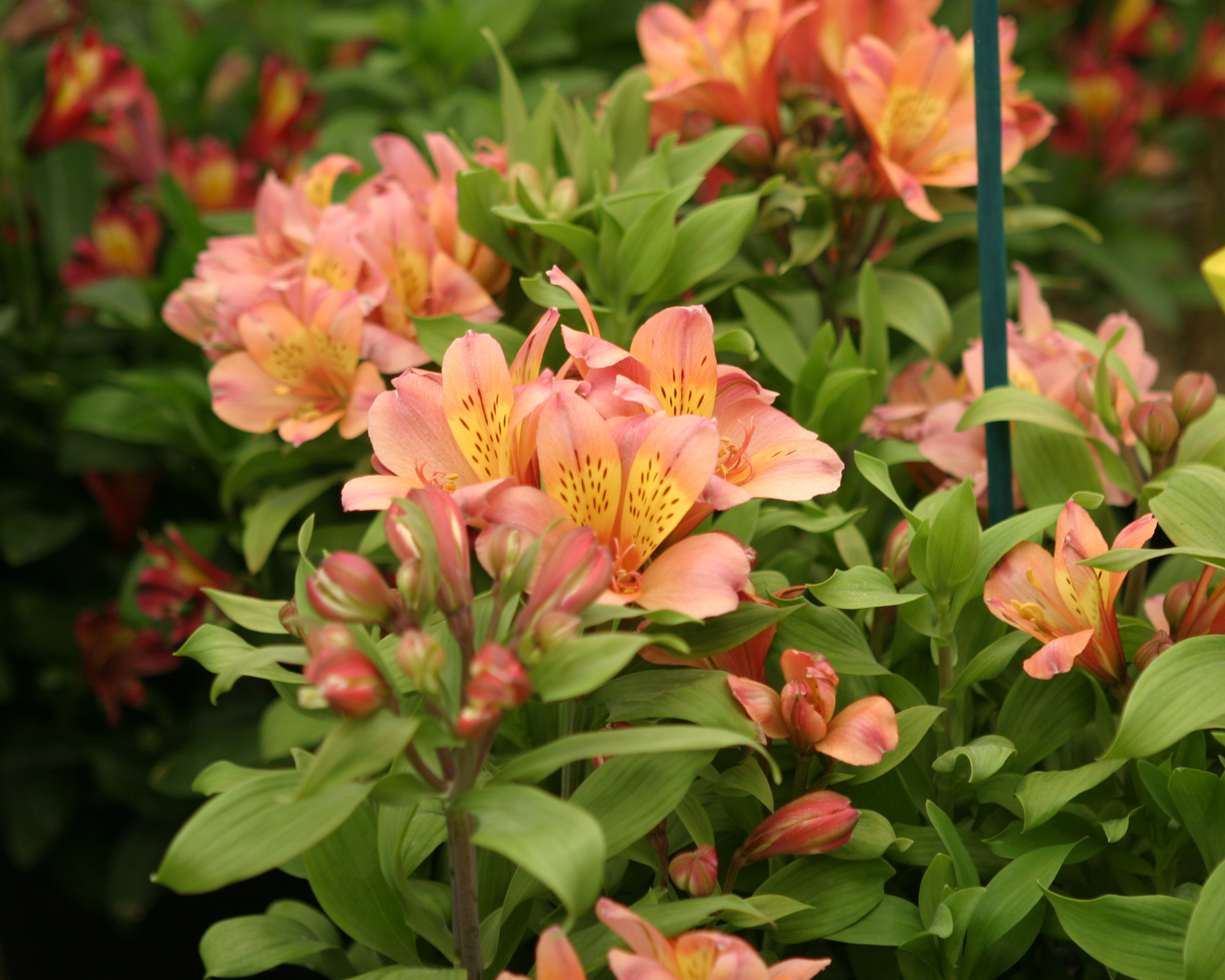
- Hardiness: USDA 8-10 (UK H4)
- Height: 1ft (30cm) to 3ft (90cm)
- Spread: 1ft (30cm) to 3ft (90cm)
- Best for: Full sun
This South American native, commonly known as Peruvian lily is easy to grow and has a fantastically long blooming period – nearly all year round if you’re able to move them to a cool greenhouse or conservatory over the winter months.
The attractive dark flecks on their petals that guide bees down into the nectar-rich centers make these one of the best tropical plants. Dark red, orange and purple varieties like look great with bold foliage plants like colacasia and cordylines, while pastel and pale varieties combine well with agapanthus.
They grow rampantly in garden borders, but in a container it’s much easier to manage them provided you choose dwarf or medium-height varieties like those from the Princess and Inca series. Plant out pre-grown plants from late spring for the best results, as growing from bare-root tubers can be tricky. When deadheading, pull flower stems from the base as this will stimulate new growth.
10. Tree ferns
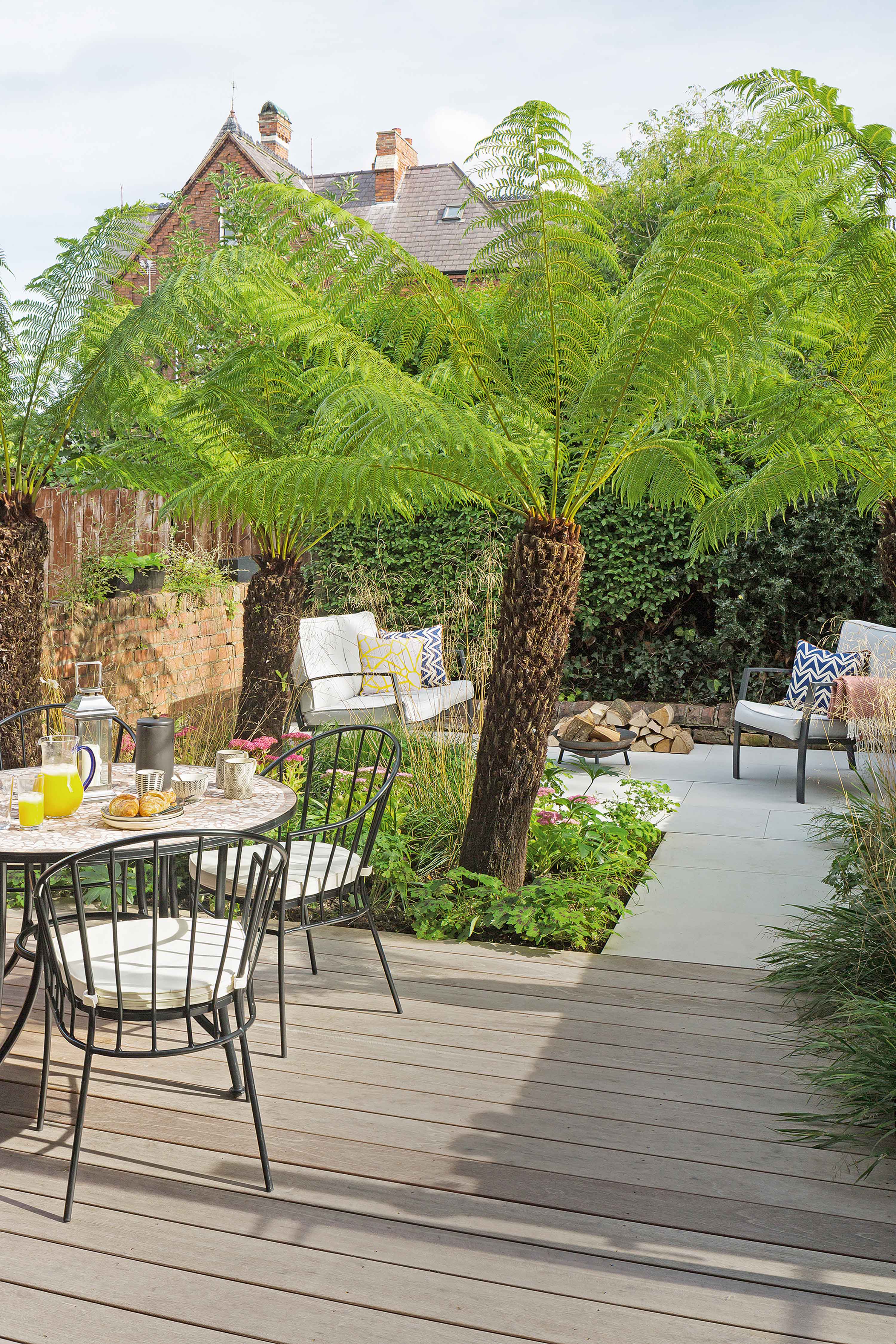
- Hardiness: USDA 9-10 (UK H3)
- Height: 13ft (4m)
- Spread: 9ft (3m)
- Best for: Dappled shade
Tree ferns like Dicksonia antarctica will add drama to any garden. To highlight their dramatic shape even more, uplight the trunks with stake lights as part of your patio lighting ideas.
They can be grown in the ground or in pots, but to thrive, they require a damp, semi-shaded spot in rich soil and out of direct sun. Coastal areas, where the atmosphere is naturally humid, often make ideal habitats.
They grow slowly, to 13ft (4m) eventually, so it’s worth buying the biggest specimen your budget will allow. Plant the trunk 6in (15cm) deep, staking taller specimens, and water liberally, up and down the trunk during the growing months (spring to fall). If tree ferns dry out, the trunk shrinks, and the fronds become stunted.
Hardiness can vary from plant to plant, so rather than take the gamble, protect your plant from frost by wrapping the trunk with straw and hessian or horticultural fleece if temperatures are likely to dip below 23˚F (-5˚C). Cut off any brown fronds in spring.
11. Agapanthus
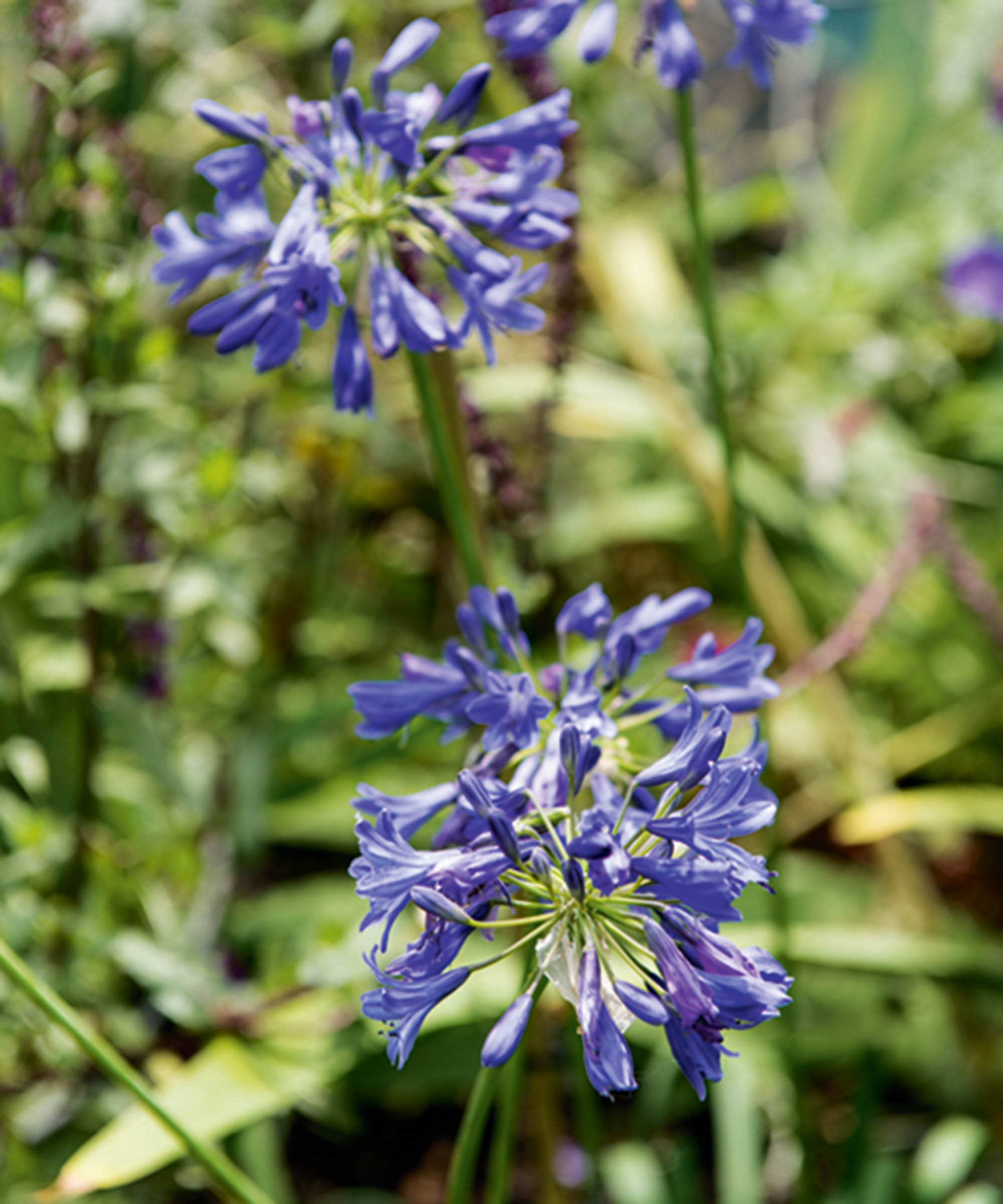
- Hardiness: USDA 8 (UK H4)
- Height: 8in-2ft (20-60cm), others up to 5ft (1.5m)
- Spread: to 36in (90cm)
- Best for: Full sun
These fabulous perennials burst into bloom in summer with firework flowerheads in shades of blue, purple or white flowers on tall stems – they’re like the alliums of summer. Despite their exotic good looks, these patio plants are low maintenance and once you’ve started growing them, you may find yourself with a mild addiction.
Because they cope well with drought and like their roots restricted, they’re perfect for containers. Agapanthus are hungry plants though, so feed them with rose fertilizer in spring and summer or give a liquid feed fortnightly during the growing season.
Evergreen varieties are less hardy than deciduous types and need to be moved indoors to a greenhouse or conservatory in autumn to protect the roots from frost. Check plant labels when buying to see if they’re evergreen or deciduous.
12. Brugmansia
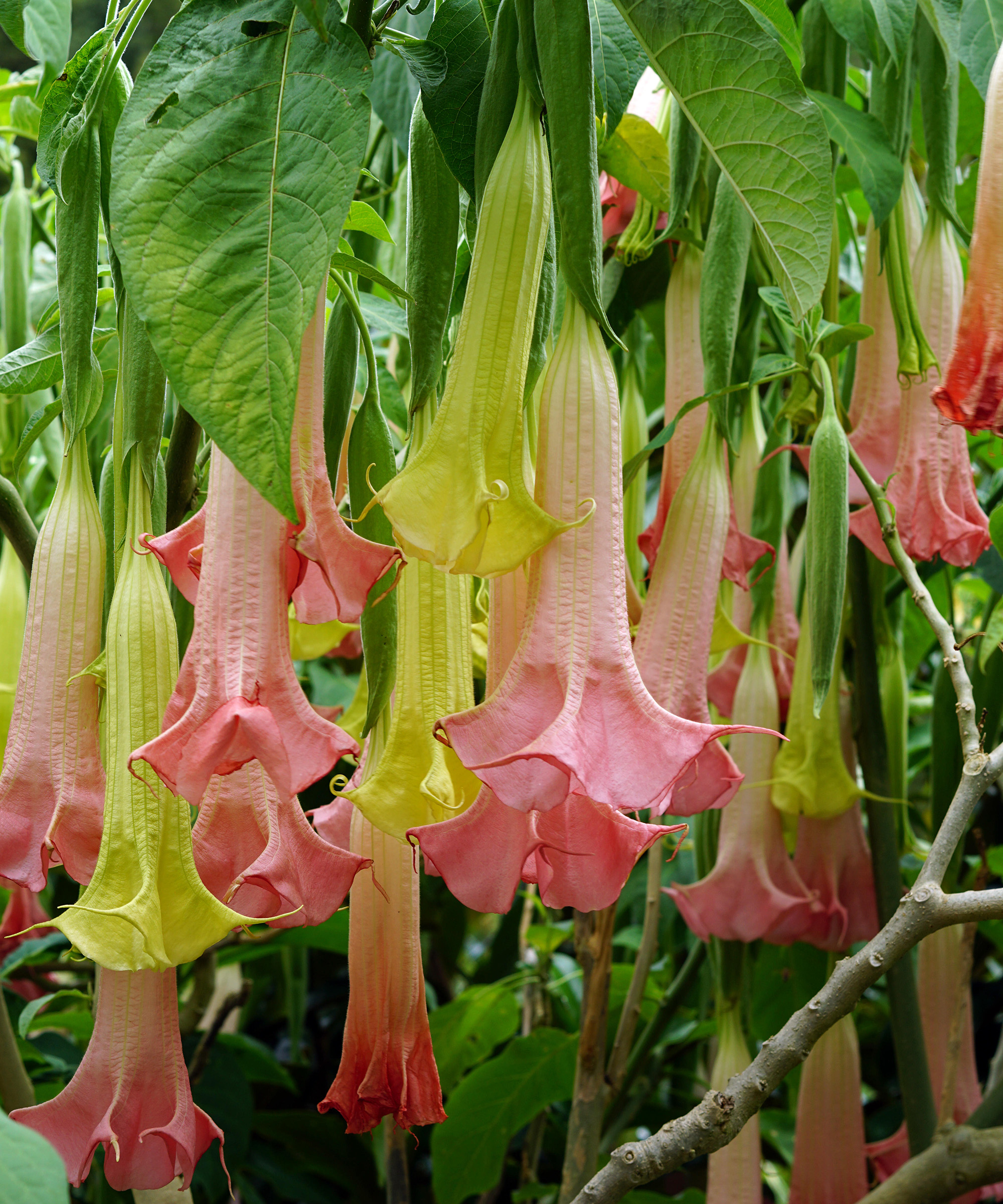
- Hardiness: USDA 11 (UK H1b)
- Height: over 6ft (2m)
- Spread: 3ft 2in (1m)
- Best for: Full sun
If you really want to make a statement on your patio and wow your garden visitors, brugmansia is a must-have. The huge trumpet like flowers of this tropical South American beauty will stop you in your tracks. Coming in shades of pink, white, yellow and red, the outsized blooms can reach 1ft (30cm) long.
Brugmansia won’t tolerate temperatures much below 44˚F (7˚C) so in cool regions it’s best grown in a large pot (at least 2ft /60cm wide) and moved indoors in fall. Using them as a conservatory plant over winter is ideal, for example.
Prune in late summer to keep them to a manageable size, cutting stems back to 2.5cm above old wood – wear gloves as the sap will irritate the skin. It’s a hungry plant, so regularly feed with a high-potash fertilizer like liquid seaweed in summer.
13. Hydrangea
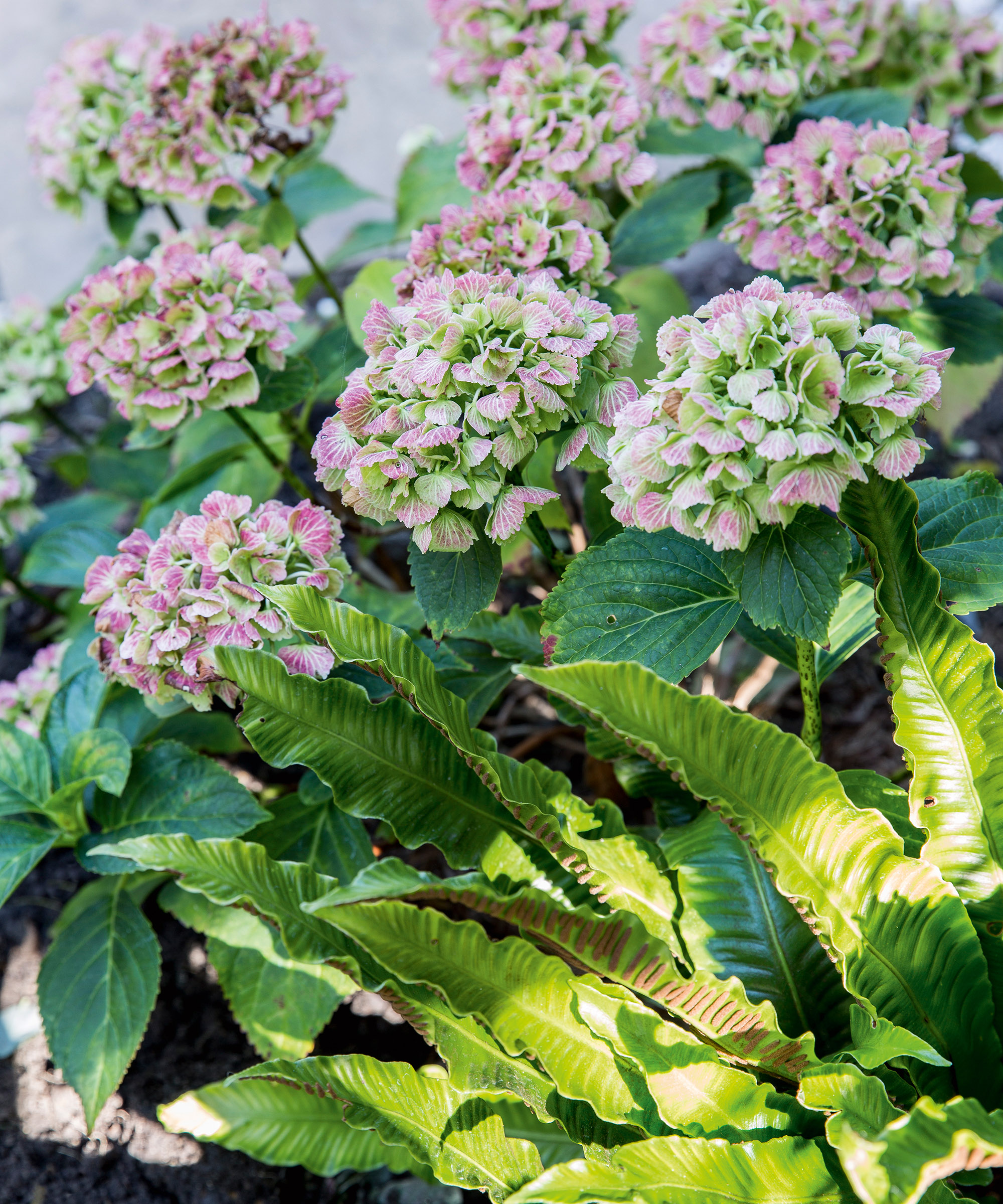
- Hardiness: USDA 5-9 (UK H5-6)
- Height and spread: check individual plant labels
- Best for: Sun/light shade
Hydrangeas are a fantastic group of plants that bring structure, color and seasonal interest to any planting scheme. Their long-lasting blooms appear from summer and carry on putting on a great show until fall. And even later than that, flowerheads left on will give shape and texture to winter patio ideas.
Some of them, like ‘Wim’s Red’, have flowers that get better as they age, turning antique shades of pink and red. The mophead types (H.macrophylla) with their out-sized rounded blooms are a crowd pleaser but some of them can reach 6ft (2m), so it might be better to try their dwarf versions like ‘Little White’ and ‘Ophelia’.
Hydrangea paniculata and the oak-leaved Hydrangea quercifolia have more conical-shaped heads and fabulous autumn colors. Wait until spring to cut the flowerheads off – down to the nearest emerging buds and apply well-rotted manure or garden compost to the base of plants. Those hydrangeas in pots will benefit from an application of slow-release fertilizer or specialist hydrangea feed in spring.
14. Coleus
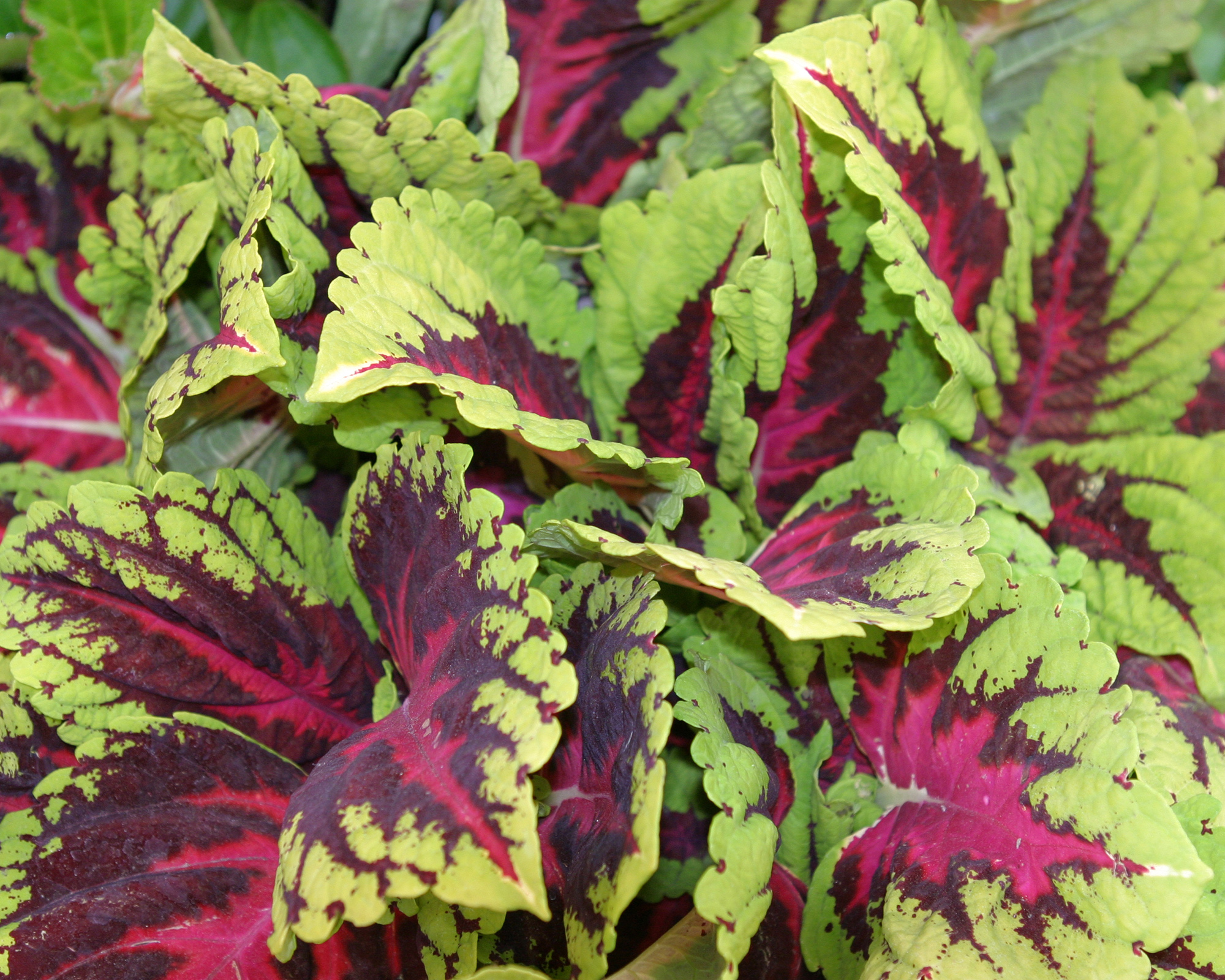
- Hardiness: USDA 10-11 (H1b)
- Height: 6-32in (15-80cm)
- Spread: 6-32in (15-80cm)
- Best for: Sun/light shade
Coleus, also known as Solenostemon, are grown for their velvety foliage that comes in psychedelic combinations of lime green, bright red, yellows, pink, brown and bronze. They’re ideal for a jungle-style planting scheme teamed up with marigolds, colocasia and canna.
They also work well in urban gardens: a vertical pocket planter filled with coleus and hung from a wall or fence makes a vibrant display. They’re frost-tender so are treated like annuals in cooler regions, planted outside at the beginning of summer and discarded or brought indoors in fall.
They make lovely indoor plants, so it’s possible to keep them from year to year. Typically reaching 12-15in (30-38cm) high, they’re perfect for the front of borders or in pots and hanging baskets. Once planted, pinch out the growing tips to encourage bushier plants. You can take softwood cuttings from them in summer, to get free plants.
15. Heliotrope arborescens
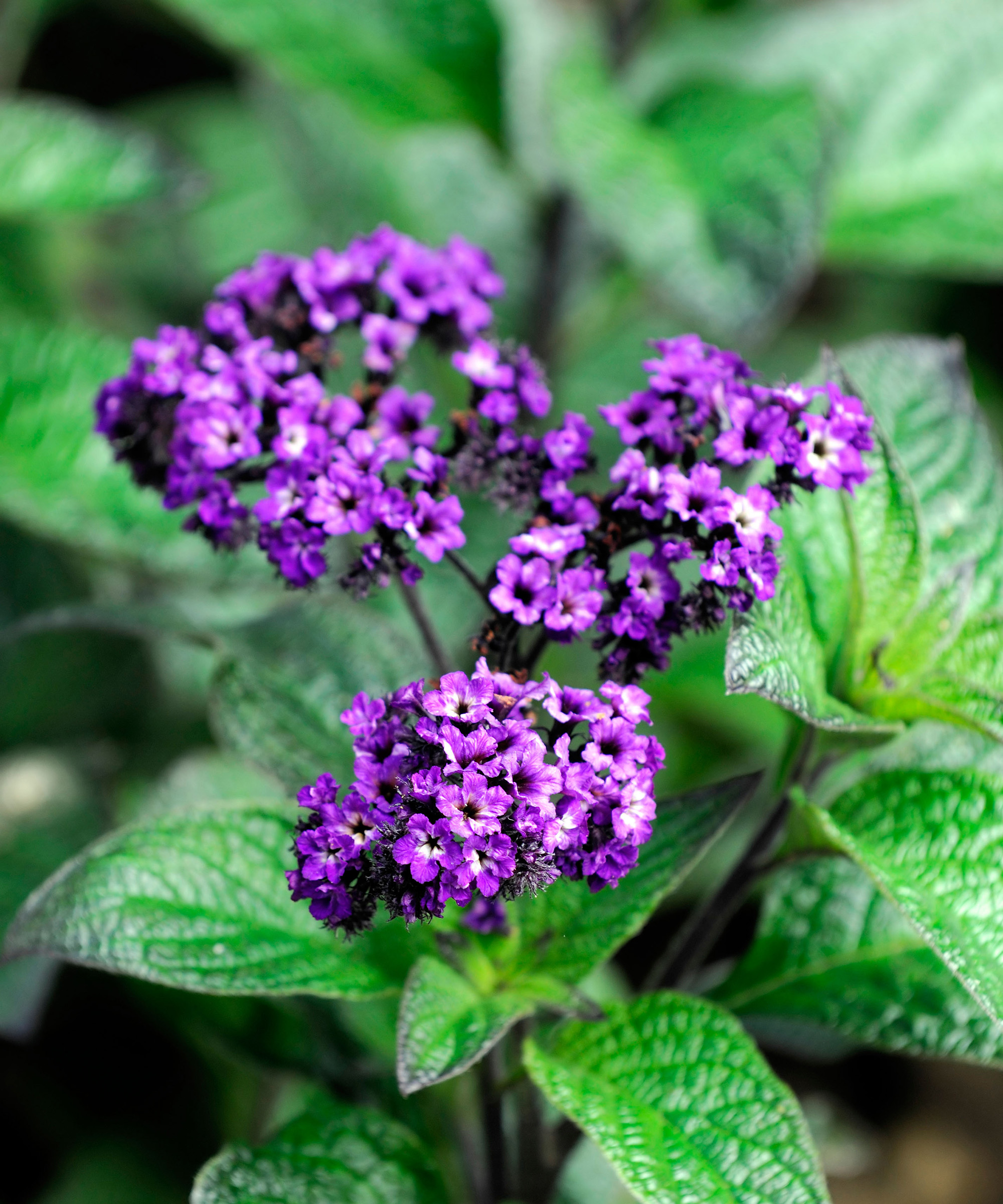
- Hardiness: USDA 9-11 (UK H1c)
- Height: 19in (50cm)
- Spread: 19in (50cm)
- Best for: Front of borders. Full sun, but give it some shade in the afternoon
The cherry pie plant has delicious cherry-vanilla scented purple blooms and attractive dark green pleated leaves. Garden centers and online suppliers usually supply them as small plants from late spring.
It’s best grown as an annual as plants can get straggly over time but you can make more plants for free by taking cuttings in summer. Heliotrope enjoys moist, free-draining soil types, which is a little challenging in containers, so use a large pot and incorporate moisture-retaining organic matter like garden compost to a John Innes No2 compost.
If you keep the compost moist and regularly feed with a high-potash fertilizer, these gorgeous plants will reward you with a beautiful display from the beginning of summer to fall. ‘Chatsworth’ and ‘Midnight Sky’ are excellent varieties. The upright flowers of Amaranthus 'Green Thumb' are a nice planting contrast to the dome-shaped blooms of heliotrope.
16. Bay trees
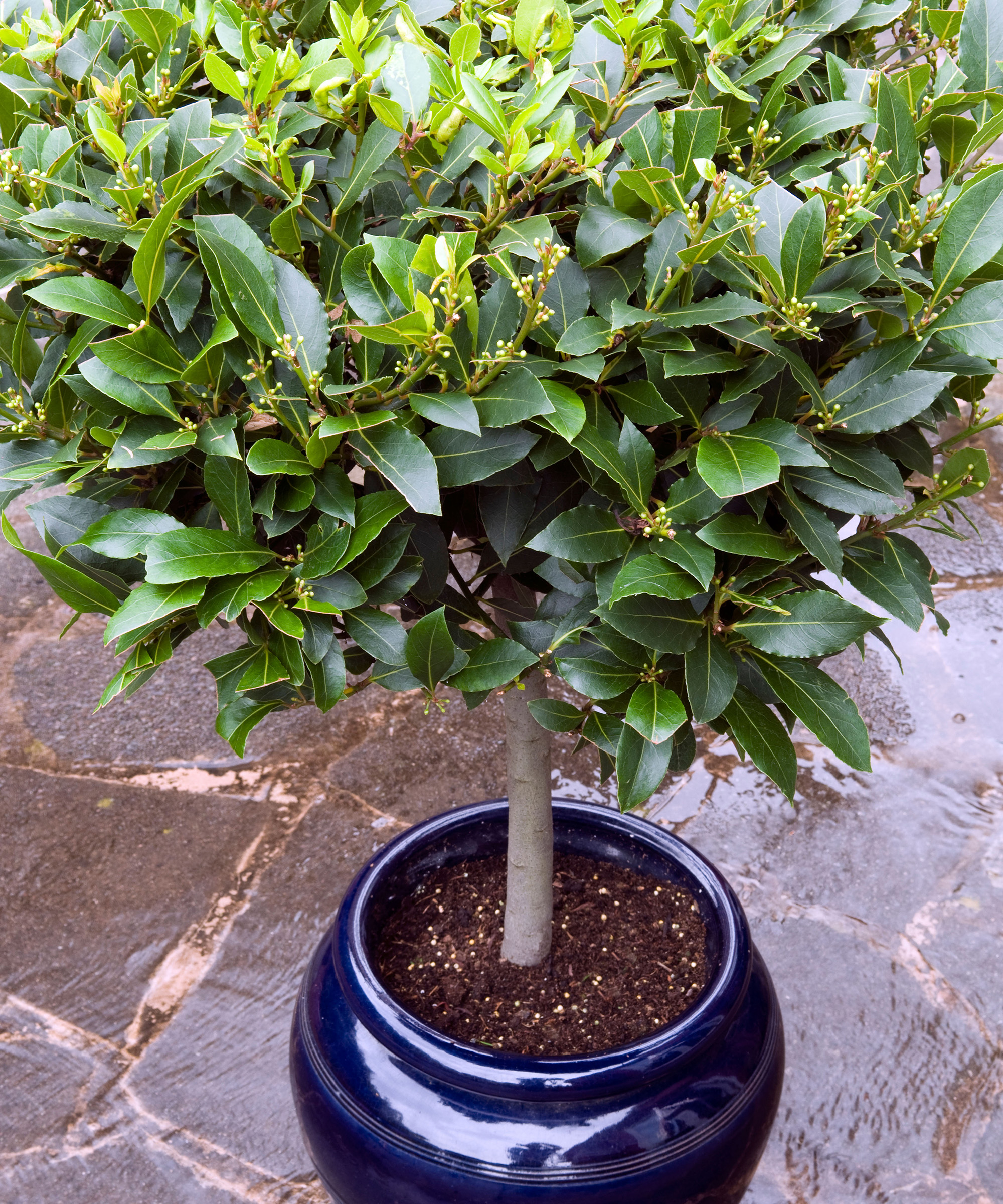
- Hardiness: USDA 8-10 (UK H4)
- Height: 4ft 6in (135cm), ideal height in a pot with regular clipping
- Spread: 2ft (60cm), ideal spread in a pot with regular clipping
- Best for: Full sun
Topiary bay trees shaped into lollipops, cones and spirals instantly smarten up a patio area, and their glossy green leaves look good all year round. For a more informal look, buy them as young plants and let them grow into their natural bushy habit. Prune them lightly in spring to help keep them compact.
They’re fairly indestructible, so if you forget to water them regularly, they’ll probably survive. To keep bay plants looking healthy grow them in John Innes No2 compost and apply slow-release fertiliser granules each spring.
They are slightly tender, especially when grown in containers, so in colder regions move them to a frost-free place when temperatures dip below 23˚F (-5˚C) or cover plants in a horticultural fleece ‘jacket’.
Aim to re-pot your bay tree every two to three years, but rather than having to keep increasing the size of the pot, tease away one thirds of the roots and re-pot into the same container.
17. Calibrachoa

- Hardiness: USDA 10-11 (UK H1b)
- Height: 20-24in (50-60cm)
- Spread: 20-24in (50-60cm)
- Best for: Full sun
This popular bedding plant, also known as million bells, comes in a wide range of shades from warm oranges and peaches to pretty pinks and purples, to bright yellow striped.
It’s a fast-grower and a prolific flowerer and will be smothered with mini petunia-like flowers from summer until the first frosts of fall. Look out for young plants at garden centers in late spring and early summer and plant them outside when night time temperatures don’t dip much below 51˚F/10˚C.
Apply a liquid feed fortnightly and make sure the compost doesn’t get overly dry. Because of its trailing habit, calibrachoa is a great plant for hanging baskets or for tall planters. ‘Rave Pink’ is an eye-catching variety with yellow stripes on bright pink petals. ‘Double Can Can Wine Red’ has unusual rich red double flowers. As with all bedding plants, choosing just one or two colors will keep schemes looking stylish.
18. Eucomis
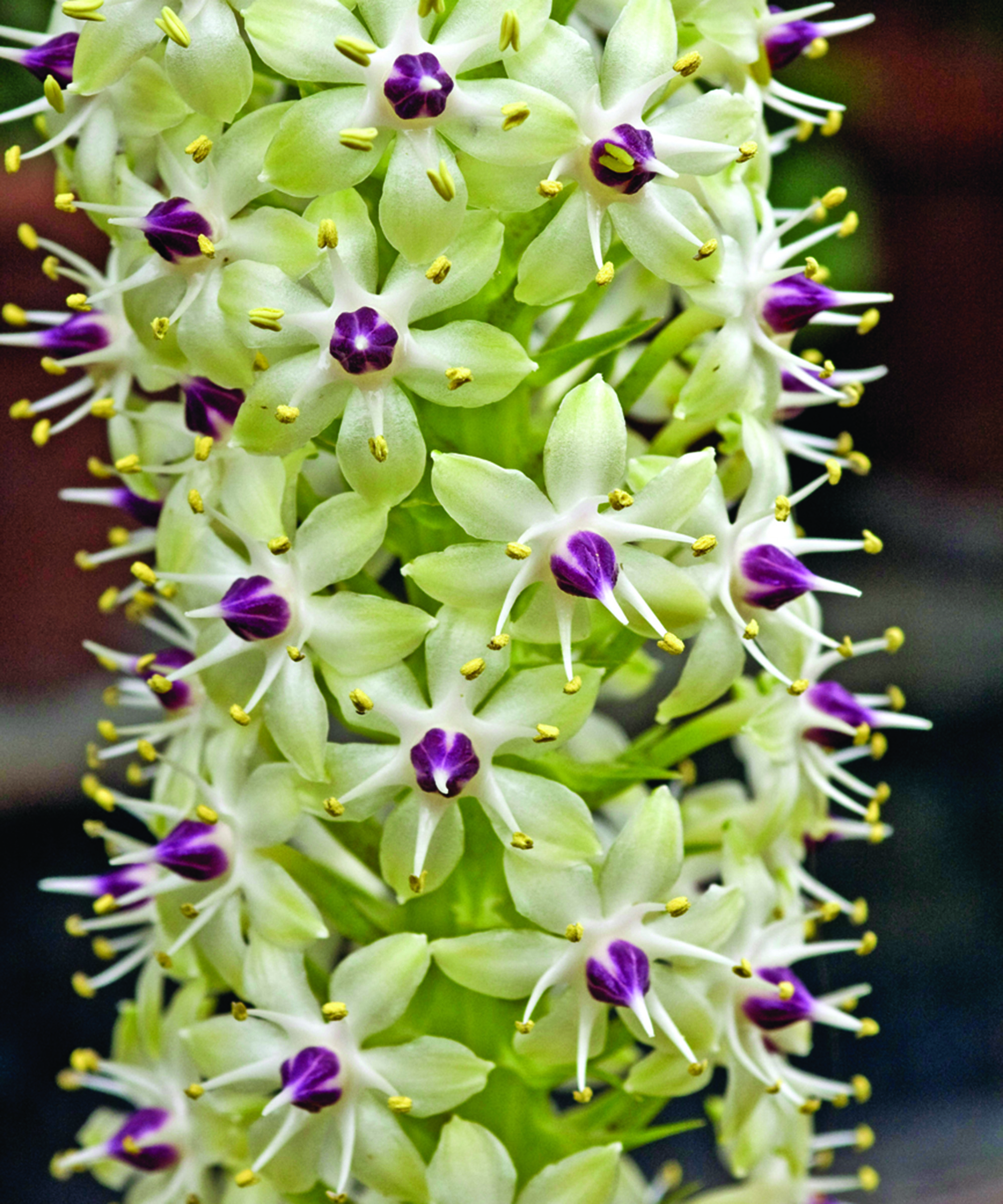
- Hardiness: USDA 8-10 (UK H4)
- Height: 4-19in (10-50cm), 5ft (150cm)
- Spread: 4-19in (10-50cm), 19in-(3ft 2in 50cm-1m)
- Best for: Full sun
Eucomis or the pineapple lily is one of the best summer flowering bulbs, offering tropical looking flower spires with tufty tops that are reminiscent of the pineapple, hence its common name. Despite its exotic good looks, eucomis is fairly easy to grow in a wide range of climate zones. If you wait until the start of spring, the bulbs can be planted directly into pots of compost outdoors.
Low-growing types like E.aloha and E.bicolor are great for shallow planters and the front of your flower beds, while the showstopper E.pole-evansii can reach a whopping 5ft (150cm) high. Keep plants well-watered and give a liquid feed fortnightly during the growing season.
The bulbs can be left in the ground all year round in zones 8-9 provided they’re buried deeply. In containers they’ll always be more vulnerable to frost damage so err on the side of caution and move pots to a sheltered spot over winter.
19. Bamboo
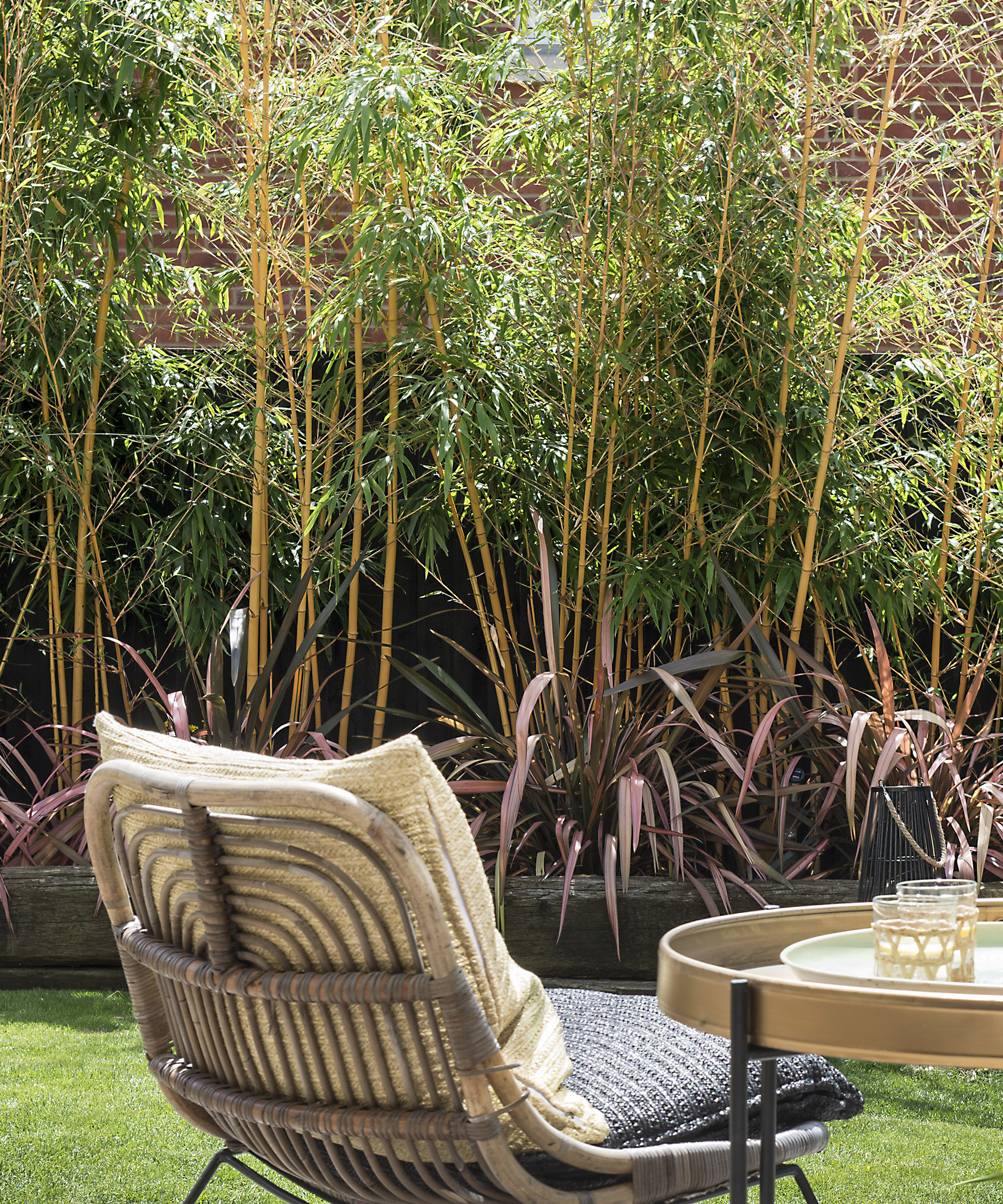
- Hardiness: USDA 5-8 (UK H5-6)
- Height and spread: check individual plant labels
- Best for: Full sun/light shade
Bamboo is a practical, as well as beautiful addition to an enclosed patio, for the tall stems with their elegant leaves act as a living privacy screen and provide shelter from wind. They’re also an easy way to soften the look of walls and fences.
When grown in containers, the roots of bamboo are restricted, so there’s no need to worry about it taking over your garden. It’s a good idea to use a planter with wheels, as once bamboo gets growing, the planters will become heavy and not easy to move. You’ll need to root-prune your bamboo every three to four years otherwise the roots will try to push through the pot as they grow.
Choose low, sturdy metal or wood planters (match them with your patio furniture ideas for a cohesive look), and go for rectangular shapes to make it easier to pull out the rootball for pruning. Fargesia varieties work well in planters for they are clump-forming not spreading, they’re also among the hardiest.
Phyllostachys needs a sunny spot but being a ‘spreader’, you’ll need to keep on top of root pruning. To get the best from your bamboo, use John Innes No3 soil and apply a general liquid feed throughout the growing season.
20. Grasses
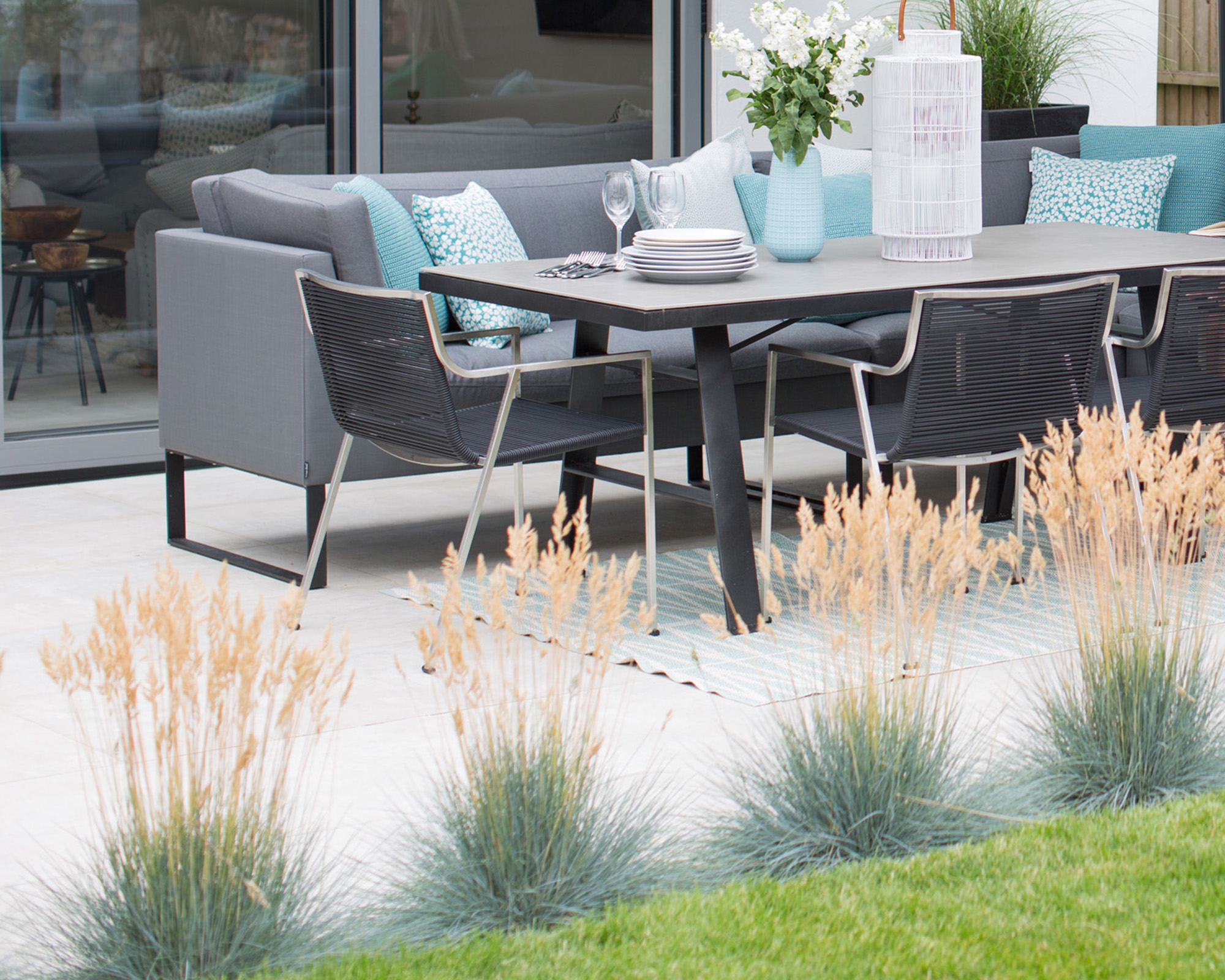
- Hardiness: USDA 6-10 (UK H4-6)
- Height and spread: check individual plant labels
- Best for: Full sun/light shade
Ornamental grasses will add wow factor to any style or size of patio, and they provide interest virtually all year round. The trick to growing them well is to choose the right variety for your growing space.
On concrete patios there are plenty of varieties that will thrive in containers - Panicum ‘Frosted Explosion’ and Pennisetum advena ‘Rubrum’ are both fabulous ‘thriller’ plants and work well with in combination with bushy bedding plants. Many types of ornamental grass can also be used around the margins of a patio as a way to define the space.
Calamagrostis Karl Foerster has an upright habit and a group of them planted together makes an elegant feathery screen. The bronze-red arching foliage of anemanthele adds color and soften the edges of borders. Hakonechloa with its graceful waterfall-like foliage, makes a fabulous style statement in tall pots.
21. Dahlias
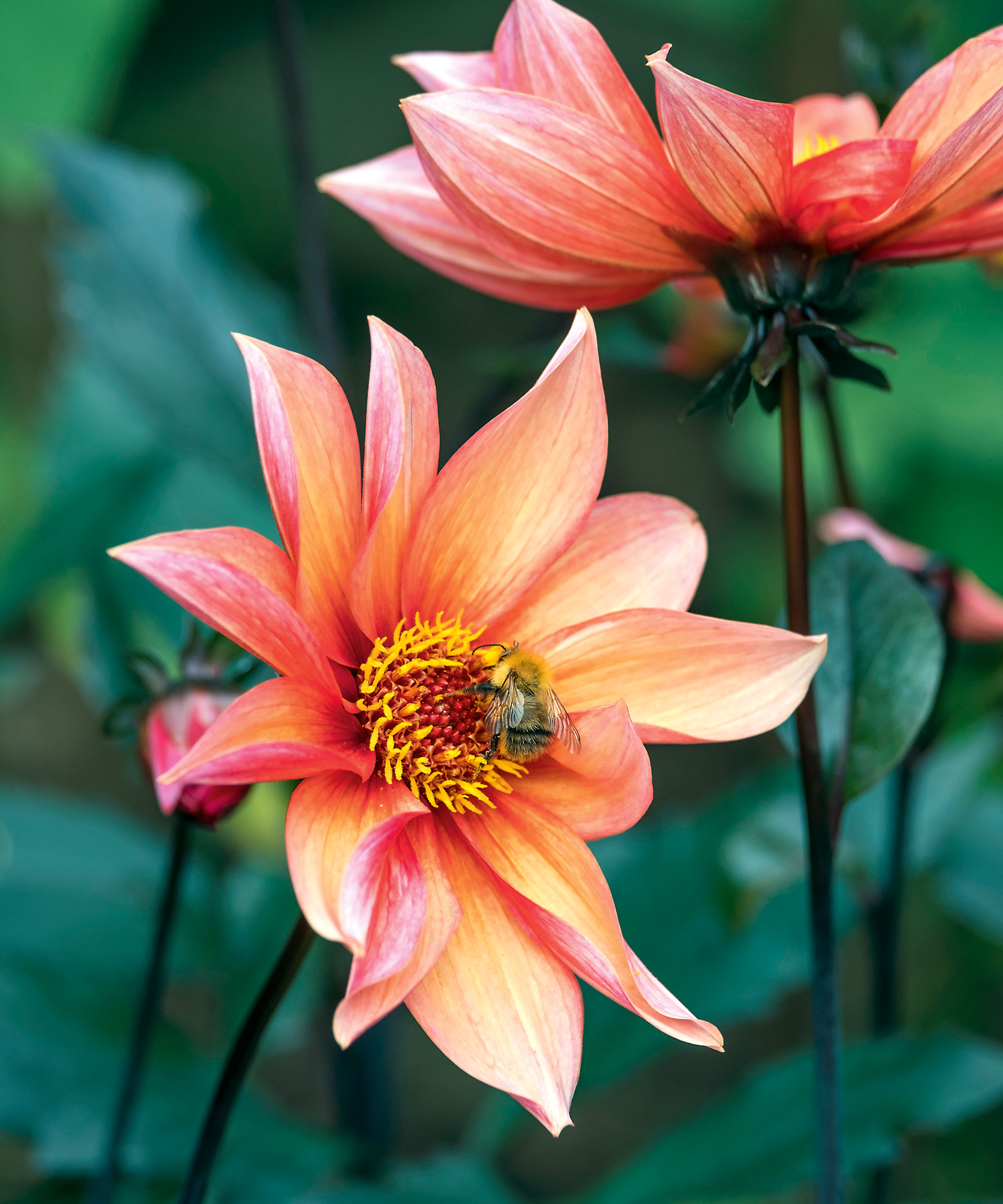
- Hardiness: USDA: below zone 9 (UK H3)
- Height and spread: check individual plant labels
- Best for: Full sun/light shade
Incredibly popular in social media and wedding bouquets, dahlias are a must-have for the style-conscious gardener. If you grow dahlias from tubers in spring, you’ll have a much wider range to choose from, but if you’ve missed the early planting window, plenty of garden centers will sell pre-grown plants from early summer.
Dahlias come in a wonderful range of flower shapes and shades, from cute orange pom-poms, to vibrant pink cactus types, to demure single flowers like ‘Wishes and Dreams’. Those over 2ft (60cm) tall will need staking and its best to choose shorter varieties for growing in patio containers.
Dahlias are hungry, thirsty plants so give them a dilute tomato feed every week throughout their growing season Move pots somewhere frost-free over winter.
How often should I feed and water my patio plants?
The soil in containers tends to lose nutrients over time as the plant takes them up, or when they wash out during watering. That’s why you need to feed potted patio plants more frequently than those in the ground. Applying slow-release fertilizer in spring and a fortnightly feed with liquid seaweed keep plants healthy and flowering well.
Always use John Innes No3 compost for perennial plants that are going to stay in their pots long-term; for short-term displays, multipurpose compost will do the job. In warm weather, pots may need watering everyday, in the morning and evenings. Regularly deadhead spent flowers to keep displays looking tidy and new flowers coming.
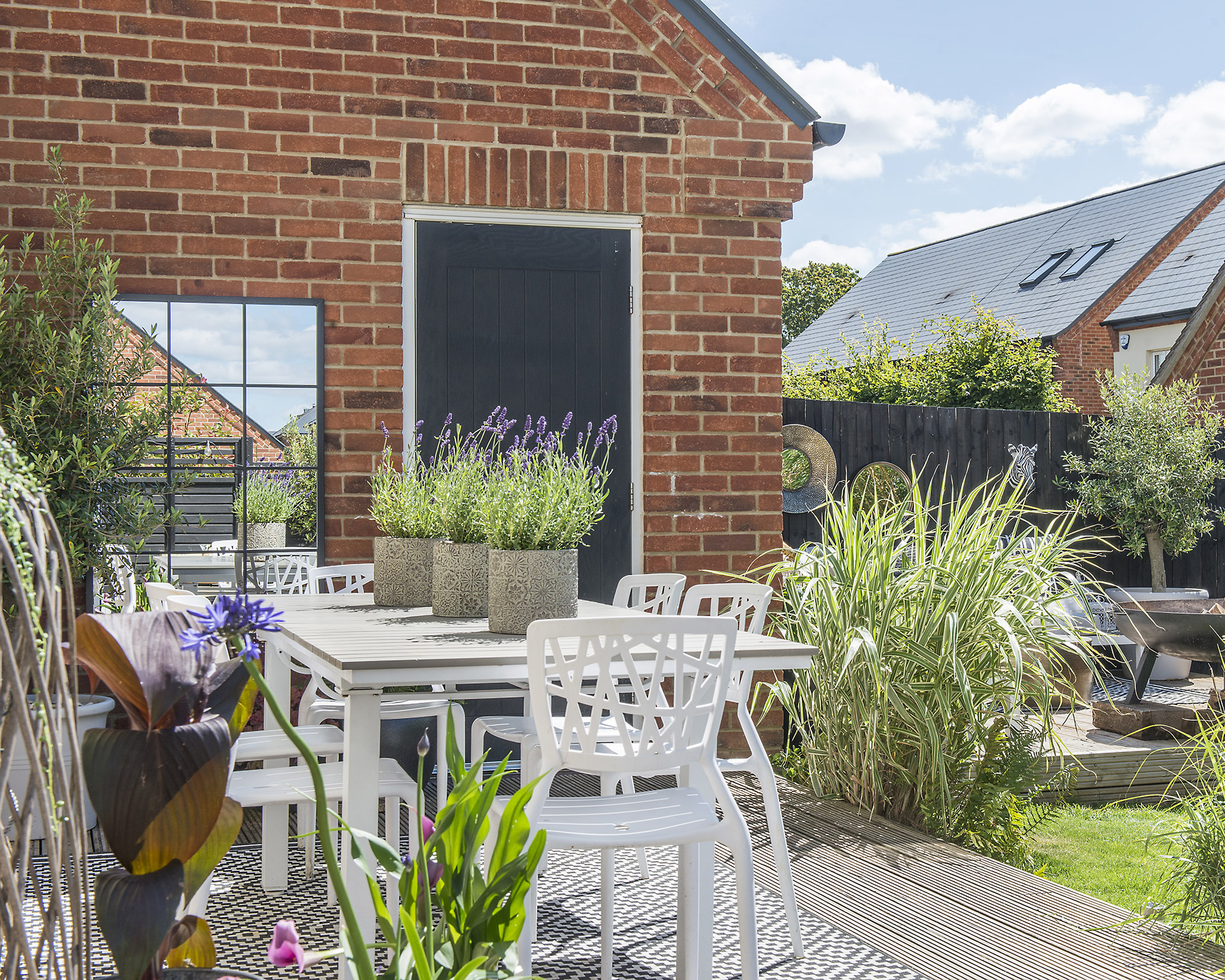
How do I choose the right plants for my patio?
Restricting your color palette will keep things looking stylish. Garden designers tend to gravitate to a pared back palette, using only a few flower shades, as well as lots of foliage plants in agreeable combinations. If you like lots of different colors, try to zone them or have a different garden color scheme for each season.
Also consider the backdrop of your house and your patio paving material. Warm sunset shades of apricot, yellow and pink go well against red brick, while bright colors pop against white rendered walls. Choosing pots that are similar in color, material or shape helps to keep a feeling of unity on the patio.

Working at a garden center when she was 23, Sally realised straight away the therapeutic power of being around greenery and nurturing plants. She's horticulturally trained to degree level and has worked on gardening magazines for over a decade. Sally now gardens in Bournemouth, UK, zone 8a (H5).
